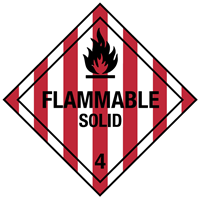
 Print
Print
Chemical Datasheet
ISOSORBIDE DINITRATE MIXTURE |

|
Chemical Identifiers
| CAS Number |
UN/NA Number |
DOT Hazard Label |
USCG CHRIS Code |
|
|
|
|
none
|
| NIOSH Pocket Guide |
International Chem Safety Card |
|
none
|
none
|
NFPA 704
data unavailable
General Description
A crystalline solid. May be toxic by ingestion. Used to make pharmaceuticals. Used as a heart drug.
Hazards
Reactivity Alerts
Air & Water Reactions
Highly flammable. Slightly soluble in water.
Fire Hazard
Excerpt from ERG Guide 133 [Flammable Solids]:
Flammable/combustible material. May be ignited by friction, heat, sparks or flames. Some may burn rapidly with flare-burning effect. Powders, dusts, shavings, borings, turnings or cuttings may explode or burn with explosive violence. Substance may be transported in a molten form at a temperature that may be above its flash point. May re-ignite after fire is extinguished. (ERG, 2024)
Health Hazard
Excerpt from ERG Guide 133 [Flammable Solids]:
Fire may produce irritating and/or toxic gases. Contact may cause burns to skin and eyes. Contact with molten substance may cause severe burns to skin and eyes. Runoff from fire control or dilution water may cause environmental contamination. (ERG, 2024)
Reactivity Profile
Nitroalkanes, such as ISOSORBIDE DINITRATE MIXTURE, range from slight to strong oxidizing agents. If mixed with reducing agents, including hydrides, sulfides and nitrides, they may begin a vigorous reaction that culminates in a detonation. Nitroalkanes are milder oxidizing agents, but still react violently with reducing agents at higher temperature and pressures. Nitroalkanes react with inorganic bases to form explosive salts. The presence of metal oxides increases the thermal sensitivity of nitroalkanes. Nitroalkanes with more than one nitro group are generally explosive. Nitroalkanes are insoluble in water. This heart drug is detonable when dry, but non-explosive with 30% of water.
Belongs to the Following Reactive Group(s)
- Ethers
- Nitro, Nitroso, Nitrate, and Nitrite Compounds, Organic
Potentially Incompatible Absorbents
Use caution: Liquids with this reactive group classification have been
known to react with the
absorbents
listed below.
- Cellulose-Based Absorbents
- Expanded Polymeric Absorbents
Response Recommendations
Isolation and Evacuation
Excerpt from ERG Guide 133 [Flammable Solids]:
IMMEDIATE PRECAUTIONARY MEASURE: Isolate spill or leak area for at least 25 meters (75 feet) in all directions.
LARGE SPILL: Consider initial downwind evacuation for at least 100 meters (330 feet).
FIRE: If tank, rail tank car or highway tank is involved in a fire, ISOLATE for 800 meters (1/2 mile) in all directions; also, consider initial evacuation for 800 meters (1/2 mile) in all directions. (ERG, 2024)
Firefighting
Excerpt from ERG Guide 133 [Flammable Solids]:
SMALL FIRE: Dry chemical, CO2, sand, earth, water spray or regular foam.
LARGE FIRE: Water spray, fog or regular foam. If it can be done safely, move undamaged containers away from the area around the fire.
FIRE INVOLVING METAL PIGMENTS OR PASTES (E.G. "ALUMINUM PASTE"): Aluminum Paste fires should be treated as a combustible metal fire. Use DRY sand, graphite powder, dry sodium chloride-based extinguishers or class D extinguishers. Also, see ERG Guide 170.
FIRE INVOLVING TANKS, RAIL TANK CARS OR HIGHWAY TANKS: Cool containers with flooding quantities of water until well after fire is out. For massive fire, use unmanned master stream devices or monitor nozzles; if this is impossible, withdraw from area and let fire burn. Withdraw immediately in case of rising sound from venting safety devices or discoloration of tank. ALWAYS stay away from tanks in direct contact with flames. (ERG, 2024)
Non-Fire Response
Excerpt from ERG Guide 133 [Flammable Solids]:
ELIMINATE all ignition sources (no smoking, flares, sparks or flames) from immediate area. Do not touch or walk through spilled material.
SMALL DRY SPILL: With clean shovel, place material into clean, dry container and cover loosely; move containers from spill area.
LARGE SPILL: Wet down with water and dike for later disposal. Prevent entry into waterways, sewers, basements or confined areas. (ERG, 2024)
Protective Clothing
Excerpt from ERG Guide 133 [Flammable Solids]:
Wear positive pressure self-contained breathing apparatus (SCBA). Structural firefighters' protective clothing provides thermal protection but only limited chemical protection. (ERG, 2024)
DuPont Tychem® Suit Fabrics
No information available.
First Aid
Excerpt from ERG Guide 133 [Flammable Solids]:
Refer to the "General First Aid" section. Specific First Aid: Removal of solidified molten material from skin requires medical assistance. (ERG, 2024)
Physical Properties
Flash Point: data unavailable
Lower Explosive Limit (LEL): data unavailable
Upper Explosive Limit (UEL): data unavailable
Autoignition Temperature: data unavailable
Melting Point: data unavailable
Vapor Pressure: data unavailable
Vapor Density (Relative to Air): data unavailable
Specific Gravity: data unavailable
Boiling Point: data unavailable
Molecular Weight: data unavailable
Water Solubility: data unavailable
Ionization Energy/Potential: data unavailable
IDLH: data unavailable
AEGLs (Acute Exposure Guideline Levels)
No AEGL information available.
ERPGs (Emergency Response Planning Guidelines)
No ERPG information available.
PACs (Protective Action Criteria)
No PAC information available.
Regulatory Information
EPA Consolidated List of Lists
No regulatory information available.
CISA Chemical Facility Anti-Terrorism Standards (CFATS)
No regulatory information available.
OSHA Process Safety Management (PSM) Standard List
No regulatory information available.
Alternate Chemical Names
- CARDIS
- CARVANIL
- CARVASIN
- CEDOCARD
- CLAODICAL
- COROSORBIDE
- D-ISOSORBIDE DINITRATE
- 1,4:3,6-DIANHYDRO-D-GLUCITOL 2,5-DINITRATE
- 1,4:3,6-DIANHYDRO-D-SORBITOL 2,5-DINITRATE
- 1,4:3,6-DIANHYDROSORBITOL 2,5-DINITRATE
- DINITROISOSORBIDE
- DINITROSORBIDE
- FLINDIX
- FRANDOL
- FURO[3,2-B]FURAN, D-GLUCITOL DERIV.
- GLUCITOL, 1,4:3,6-DIANHYDRO-, DINITRATE
- GLUCITOL, 1,4:3,6-DIANHYDRO-, DINITRATE, D-
- HARRICAL
- ISDN
- ISODINIT
- ISOKET
- ISOKET RETARD 40
- ISORBID
- ISORDIL
- ISORDIL TEMBIDS
- ISOSORBIDE 2,5-DINITRATE
- ISOSORBIDE DINITRATE
- ISOSORBIDE DINITRATE MIXTURE
- ISOSORBIDE NITRATE
- KORODIL
- MAYCOR
- NITROSORBID
- NITROSORBIDE
- RESOIDAN
- RIGEDAL
- SORBANGIL
- SORBIDE DINITRATE
- SORBIDE NITRATE
- SORBIDILAT
- SORBIDNITRATE
- SORBITOL, 1,4:3,6-DIANHYDRO-, DINITRATE
- SORBITRATE
- SORBONIT
- SORBOPERCUTEN
- SORQUAD
- TYB 3215
- VASCARDIN
- VASORBATE


 Print
Print
